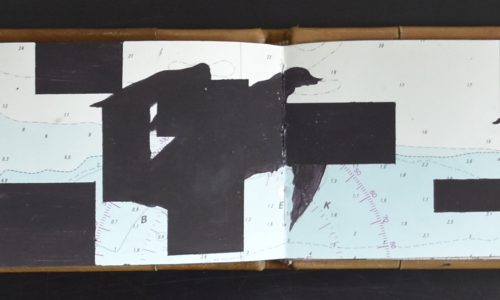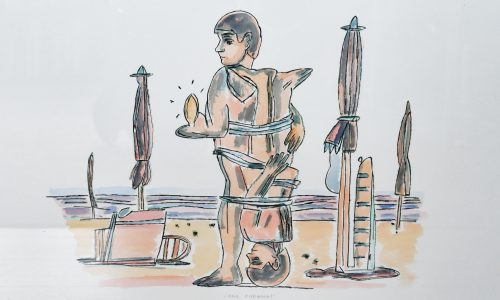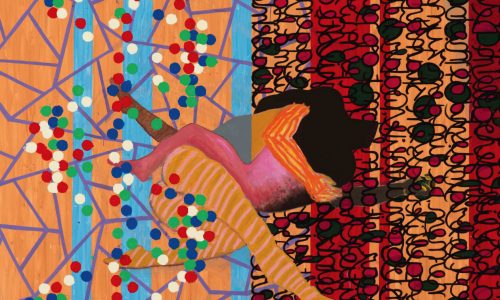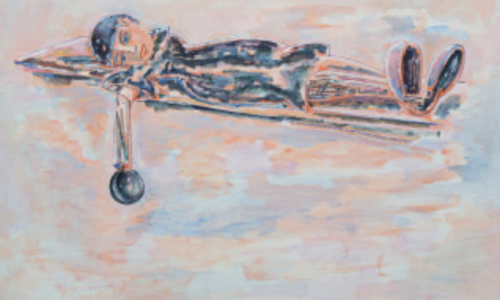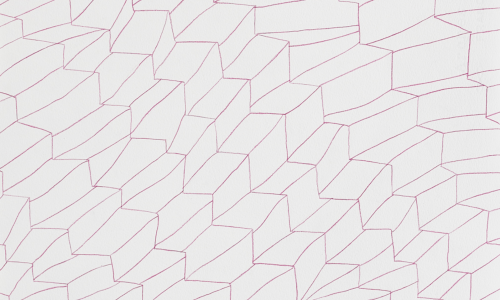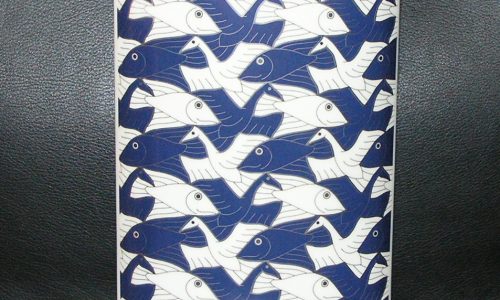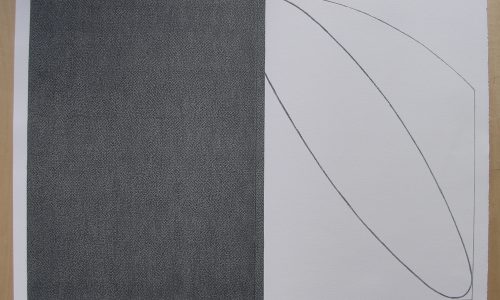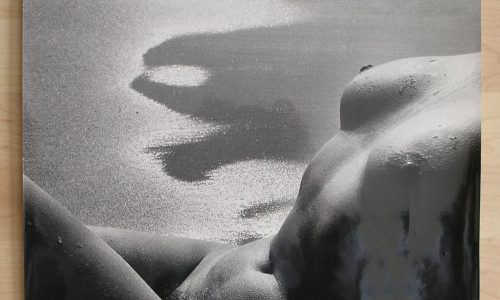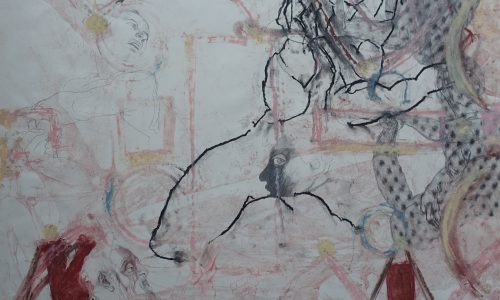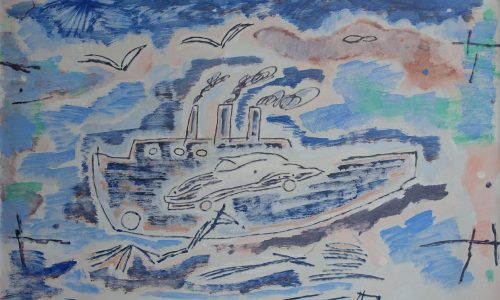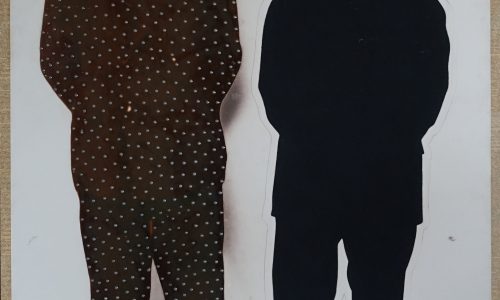
We are the same age and in all these years of collecting I had never heard of Ignasi Sumoy, an artist born in Barcelona, but beside Spain and the Netherlands hardly known in the rest of Europe, It is because I acquired the “Galerie de la TOUR” catalogue ( available at www.ftn-books.com) /Groningen(1989), that I now know Sumoy and his works. Leafing through the book i noticed elements from Ethnic art, Basquiat and the dutch painter Lucassen combined into a personal painting “language”.

I like these kinds of paintings with realistic and symbolic elements composed in an abstract setting. here is the article I found on the Sumoy site which explains more on this artist:
IGNASI SUMOY BOLUFER (Barcelona, 1953)
Ignasi Sumoy’s painting is, paradoxically, in the desert. It is a dessert that can be turned into a likely metaphor as an implicit reference to all the progressive shifts -at times geometric- that many of the visuals arts have been going throughout in the last few years: a stage empty in origin like the desert in which under controversial but more or less homogeneous appearances there lies concealed the changing outline of the dunes. Not only do the sand-hills move, covering large distances because of their specific weight, they take on their own corporality and dimensions, non-transferable, subtly recognizable and subject at times to sudden change both in direction and composition, weight and mass. So the shift and well-nigh solid individuality of the dunes enable us to speak of some of the essences of the artist’s work. But Ignasi Sumoy’s painting, on the contrary, takes its point of departure from this kind of metaphorical recurrence of the idea of the dune, arid and almost prosaic, to participate immediately in its complete geographical opposite, in its opposition of ideal behaviour: life in and of the city, always understood from the particular viewpoint of one who seeks to locate it as an entity midway between apocalyptic-futurist and a re-creation deriving from the experiences of life and aesthetics of the past, a point in time where this Futurist aspiration occurred, together with other reminiscences of Primitivism still close in time and, even more, in the segment of space.

Formally, this is one of the points of departure of his work. Without abrupt breaks, the connection between the various stages of his work has been maintained intact -and completely traceable- during the course of recent years: where formerly there existed a primitive, rather schematized being, without any clearly defined environment, urban, metropolitan man now lives. Unlike the universal prototype established by Musil, he is endowed with attributes that are not only specifically human, they serve to identify him, and even more, he identifies himself through them, thereby constructing a peculiar life-from in a peculiar kind of city locales somewhere between the ideal and the throw-away, formed by beings that mimic the physical elements of their environment so well that it finally takes them over, and in so doing becomes them themselves, assuming all the risks but also all their virtues, and hovering thus between outright apologetic qualities and the most violently critical allusions, maintaining a specific space, a private no-man’s-land where the action unfolds and where the most immediate and evident narrative events of his painting take place.
There is a kind of split suggested by the overall theory of his work that relates as much to the hypothetical apology-refusal already mentioned as to the fact that the characters take one another voice, that is, the recourse to the other and the double so strongly personified here, as though it were some terrifying Bernhardian voice imitator. This basically constitutes one of the founding elements the artist likes to play with, out of which he can build a new aesthetic space and, why not?, a new living space, made up of a personal symbology charred with unique systems and references. Out of reinterpretations, Ignasi Sumoy ends up creating a new, self-contained building, inside which the elements that live there and those that slip in from the world of meaning outside, function according to their own laws. In the realm of idiolect, the slight degree of referentiality matters little, nor what side the scale of referentiality tilts, whether towards resemblance or something real. So the problems of illusion are equally unimportant there too.
In an odd kind of pensée du dehors, Ignasi Sumoy’s painting includes an active and always strange theory that begins with inclusion and ends with rejection, working through a considerable process of selection and refinement both formal and conceptual in nature. In a process not so much of mimicry as ingestion and consumption, anything that resides outside of man ends up assimilated inside, participating in what we could call his natural conditions, becoming one more part of his anthropomorphic definitions to which it is added and which it modifies to a greater or less extent. The use of metasigns and the written language -of the word, in short- has the effect of intensifying the characteristics of reflection: What more human, therefore, than the possibility of voice in the form of articulate speech? And what more civilized than recourse to written cries? So then, his titles become external words and elements equally derived from outside; not simple denominating devices, they frequently coincide, having already been quickly and violently digested. Also, having recourse to verbal/written language allows parallels to be set up between the textual unfolding occurring in the pictures and a kind of iconographical unfolding, formal in the repertoire, that servers to distribute the leading roles. But they are always the same characters, the same characters, the same doubles, treated alike and referring of similar questions.
The building are bodies; spirals, bodies too. Triangles are heads, the gears mouths, tracks are feet, and forks, the sexual organs. But this is not the man-machine, as Kraftwerk sang; rather, we are confronted with the same process that schematizes thought and action. Nor is it a clumsy or puerile criticism of the general dehumanization or advanced industrialization that depersonalizes and homogenizes humans and objects. That would be too immediate. It may be a search for Utopia, not as a liberation, unattainable because so strongly desired, but as future, a kind of private S.F. that invites us to speculate on this present, however subjective.

Like this:
Like Loading...




















































